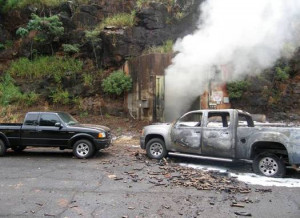At 8:50 am, an explosion and fire occurred at a magazine used for the storage of seized contraband fireworks (bunker buried in a hillside). Three shipments of consumer fireworks (labelled 1.4 G) from China had been seized between 2007 and 2011 because their physical characteristics where corresponding to 1.3G display fireworks. The fireworks involved in the incident were seized in 2010 and consisted of multi-tube devices known as cake fireworks, which are made up of individual firework tubes linked by pyrotechnic fuse. Each firework tube contains a lift charge and aerial shell.
At 7:15 am, a team of 6 persons started disassembling one-inch tubes on a cement loading dock located directly in front of the magazine entrance to prepare them for disposal. They cut into the individual firework tubes by hand using a PVC pipe cutter or knife and separated the individual explosive components contained within each tube, the aerial shells and the black powder (which functions as a lift charge) into cardboard boxes.
At 8:30 am, it began to rain heavily, and the workers quickly moved materials involved in the disassembly process including tools, chairs, and boxes containing aerial shells, black powder, and partially disassembled firework tubes to just inside the magazine entrance. Minutes after the project supervisor left the magazine to make a phone call, an explosion occurred (mass detonation) and a fire ensued, killing the 5 employees that had remained inside and injuring slightly the 6th one.
The investigation carried out by the US chemical safety board (CSB) pointed out the following key findings :
- the company, qualified for the disposal of unexploded weapons such as grenade or land mine, had no experience in fireworks disposal. The fireworks disposal process that consisted in soaking the fireworks in diesel fuel before burning them in drums on a nearby shooting range, was invented and its hazard analysis was clearly insufficient.
- the personnel lacked the training, experience, and knowledge of procedural safeguards for the safe conduct of the fireworks disposal.
- the company twice modified the process, allowing the accumulation of substantially large quantities of explosive material in boxes, greatly increasing the potential explosion hazard. This change to the disposal process was not adequately reviewed for safety implications.
- a number of possible ignition sources were identified in the magazine, including sparking tools, a metal hand truck, a rolling office chair, and plastic bags capable of producing static discharge.
The CSB also underlined an insufficient federal contractor selection and safety oversight requirements for hazardous activities as well as a significant gap in regulatory and industry standards pertaining to fireworks disposal.




